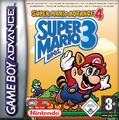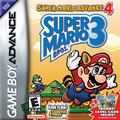Super Mario Advance 4: Super Mario Bros. 3
Template:Infobox Super Mario Advance 4: Super Mario Bros. 3, known in Japanese as スーパーマリオアドバンス4 (Sūpā Mario Adobansu 4) is a port of Super Mario Bros. 3. It is the fourth and final entry in the Super Mario Advance series of games on the Game Boy Advance. It boasted similar graphics and sound to the Super Mario All-Stars version, and made use of the e-Reader. A few e-cards came included with new copies of the game, while two sets (referred to as "series") of cards, were released and sold alongside the game. By scanning special cards into the e-Reader, players were able to upload items, videos, and most importantly, new levels into game. One notable item was the Cape Feather from Super Mario World, which allowed Mario to transform in Cape Mario. There were also two Switch cards that the player could activate (and deactivate) the effects of by scanning them; the Orange Switch and the Blue Green Switch. Scanning these switches triggered small functions in the game. The e-Reader feature is still available in the European version, but disabled by default and inaccessible. It is fully translated, probably because the e-Reader was planned to be released in Europe. It can be "unlocked" by having a corrupted save file.[1]
Story
The story, from the instruction booklet:
The Mushroom Kingdom has remained a peaceful place, thanks to the brave deeds of Mario and Luigi. However, the Mushroom Kingdom forms an entrance to the Mushroom World, a place where all is not well. Bowser sent his seven children to make mischief in this normally peaceful land. As their first order of business, they stole the royal magic wands from each country in the Mushroom World and used them to turn the Mushroom Kings into animals. Mario and Luigi must recover the royal magic wands from Bowser's seven kids to return the kings to their true forms. As Mario and Luigi set off on their journey deep into the Mushroom World, Princess Peach and Toad have but one thing to say: "Good-bye, and good luck!"
List of changes
There are many changes between the original Super Mario Bros. 3 and Super Mario Advance 4.
- If the player warps to World 8, Bowser's letter will appear on screen as if the player completed World 7.
- After Mario or Luigi defeats Bowser, he automatically triggers the ending cutscene instead of requiring the player to manually move him to the door leading to Peach's room in order to view the ending, probably because of the potential risk of accidentally falling into the void Bowser created by slamming the floor and therefore losing a life.
Gameplay changes
- Getting a Fire Flower or Raccoon Leaf when Mario is small will change him to that state instead of changing him to only Super Mario.
- Koopa Troopas can now be stomped underwater.
- Upside-down Spiny shells can be safely touched, stomped or kicked from above without taking damage; in previous versions, even an immobile, upside-down Spiny shell would hurt Mario if he landed on top of it.
- Giant Brick Blocks can be broken with a tail swipe as Raccoon or Tanooki Mario/Luigi.
- Spade Panels can produce different variants in response to completing one. The order is: Spade, Heart, Club, Diamond. Each one allows the player the chance to earn more lives.
- Mario or Luigi can have up to 999 lives.
- Hammer Mario can slide down hills.
- Pressing the
 button brings up the e-Reader menu.
button brings up the e-Reader menu. - Like in Super Mario World and newer games, each enemy defeated by Invincible Mario will be worth double the points as the last, eventually leading to extra lives.
- Just like in Super Mario World, Super Mario Advance 4: Super Mario Bros. 3 lets the player carry shells through pipes to new areas.
- In Super Mario Advance 4: Super Mario Bros. 3, tail swiping a Muncher won't turn it into a Used Block.
- Kicked shells and ice blocks can collect coins. Coins collected this way are worth double.
- Based on one of Cape Mario's moves, if Raccoon or Tanooki Mario or Luigi tail swipes a Super Mushroom, it will move away from him.
- A new game over message appears before the Continue/Quit menu, and it is impossible to save after a game over in Super Mario Advance 4: Super Mario Bros. 3.
- The P-Meter lasts longer.
- Brick blocks that contain something don't turn into a "fake" coin after a P-Switch is activated.
- The inventory window is much larger.
Level design changes
- The bonus area in World 1-2 now has far more coins.
- In several levels of Big Island, just before the Goal Panel, there is a coin bonus in the sky.
- The ending of World 3-5 has a shorter expanse of water, and a 1-Up hidden above it.
- In The Sky, some brick blocks that otherwise make Pipes and Bullet Bill cannons float in the air contain coins.
- In Iced Land, the path to the Mushroom House was changed so the player does not have to do 6-5 to access it.
- Some enemies are changed. For example, the first pipe in level 1-1 contains a normal Piranha Plant instead of a Venus Fire Trap.
- One cannon was removed from the World 8 Battleship level.
- The first tank level in World 8 is shorter, with the removal of the first two tanks after the first ? block. Similar things were done in the World 8 Airship.
- Several platforms throughout the game were made longer.
- As this is Super Mario Advance 4, one of the two "3's" made of blue coins in 5-1 was changed to a "4".
- Before facing Boom-Boom, steel blocks will block the entrance.
- Entire structures in some levels are altered to fit on a smaller screen, such as lower ceilings, higher lava pits, and slightly different stairs.
Graphical changes
- A few sprites were slightly improved. For example Mario and Luigi wear their gloves. Previous versions had the two with no visible gloves, the NES version due to color limitations and the All-Stars version for unknown reasons
- Sprites have a slightly brighter color, but not as noticeable as the other Super Mario Advance games.
- Princess Peach received a new sprite for this version.
- Pile Driver Micro-Goombas are colored differently and don't shine like actual brick blocks.
- In World 4, the map icon for the Sledge Bro. got modified to make it look more like an actual Sledge Brother. Their SNES map icon was merely a green Hammer Brother.
- Some effects were added:
- Shooting a fireball at Bowser or Boom-Boom causes him to turn red for an instant.
- Using a Warp Whistle in Super Mario Advance 4 causes the screen to blur out.
- After a P-Switch is activated in this game, it disappears in a puff of smoke after one game second.
- In Super Mario Advance 4: Super Mario Bros. 3, the "1UP" icon grows bigger before it disappears.
- World 8's name was changed from "Castle of Koopa" to "Bowser's Castle".
- In World 5, the map of the ground seen from the sky was moved up and right hiding the little mistake they made on the "Ground Map" on the NES and SNES versions.
- Spade Panels (which were called "cards" in the SNES original) get a major design change. Also, they no longer show a zoomed-in view, a drumroll starts when two-thirds of an item are lined up, and a different music plays after an item is lined up.
- Many levels are given more fitting backgrounds, like the All-Stars version. However, during most overworld levels (except for underground levels, airships, and fortresses) there is no horizontal parallax scrolling in the background although this did appear in the All-Stars version and a beta trailer shown at E3. There is still, however, vertical parallax scrolling which can be seen as Mario flies upward.
Textual changes
- Mushroom Kings have slightly different speeches. They start out with "Oh, splendid! Splendid!" opposed to "Oh, thank heavens!"; "I'm" was changed to "I am"; and the word "Princess" no longer has improper capitalization.
- When entering part 2 of the World 8 map, Princess Peach is shown above the second pipe. She yells "Mario!" if the player is Mario or simply screams if the player is Luigi before disappearing.
- Princess Peach says her new thank you message instead of the previous versions like in NES and SNES.
- If the player finishes all the levels, staff credits are shown at the end along with the cutscenes and world names, along with the alternate ending music mentioned below.
Audio changes
- Mario, Luigi, Princess Peach and Boos feature voices.
- Some aspects of the game's soundtrack were changed:
- New "happier" music plays when in a Bonus Area, instead of the underground theme.
- The short tune heard after defeating Bowser was changed from the same one heard after saving a Mushroom King to the tune heard after defeating him in Super Mario Bros..
- An alternate ending song, which features the Super Mario Bros. ending theme remixed, is played when the player finishes all the game's levels. The original ending song is only heard if the player beats Bowser without finishing all the levels.
e-Cards
For a complete listing of the cards themselves, see Super Mario Advance 4: Super Mario Bros. 3 e-Cards. The list of features added to Super Mario Advance 4 by the cards is as follows:
Exclusive features
- See-saw platforms
- Grey Brick Blocks (Can only be destroyed by Hammer Suit or crushed by Tanooki Mario's statue)
- ! Switch
- Rotating Blocks
- Sideways Venus Fire Trap
- Advance Coins
- e-Coins
- Invisible Blocks (can be visible when Mario transforms into the Tanooki Mario statue)
- ? Block with Goomba's Shoe
- Grey spike Donut Lifts
- Blue Boomerang
Features and enemies from past titles
- Super Mario Bros.
- Lifts
- Firebars
- Balance platforms
- False Bowser
- Super Mario Bros. 2
- Vegetables
- Sand able to be dug
- POW Blocks
- Locked doors
- Hoopsters
- Flurries
- Porcupos
- Super Mario World
- Cape Feather/Cape Mario
- Stretch Blocks
- Triangular Blocks
- Snake Blocks
- Trampolines
- Roulette Blocks
- 3-Up Moon
- Keys
- Spike Tops
- Cross-shot Bullet Bills
- Lil' Sparkies
- Hotheads
- Bony Beetles
- Thwimps
- Magikoopas
- Amazing Flying Hammer Bros.
- Rip Van Fish
- Jumping Piranha Plants
- Monty Moles
- Wigglers
- Kuribon
- Para-Goombas
- Gray Bowser Statues
- Gold Bowser Statues
- Falling Spikes
- Big Boos
- The Big Boo
- Chargin' Chuck
- ? Blocks with Coin Snakes
- Super Mario World 2: Yoshi's Island
- One-way gates
- Bumpties
- Super Mario Advance
- Giant Vegetables
- Items trapped in bubbles
Beta elements
Glitches
Reception
The game received mostly positive reviews, considered one of the best Game Boy Advance games ever made.


